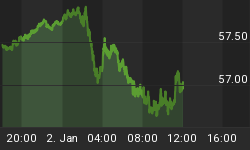"Not until Thursdays' productivity report is there a significant chance of domestic economics driving a rally in metals… The path upward has been reopened for gold and silver to drift higher towards a retest of the recent highs, which will provide significant resistance. Just as many speculative traders go long, the threat is that a failure from the $700 area would either appear to be a double top or be labeled a corrective move up before a new impulsive wave down." ~ Precious Points: Why Not Gold?, April 28, 2007
Expectations were uncertain going into the productivity report, but Thursday's numbers came in better than expected and provided the anticipated rally in metals, though not before a somewhat harrowing selloff through recent support. Unfortunately, despite the run over S&P 1500, Friday's anemic job growth and higher unemployment tempered optimism and left the overall outlook unclear and little changed for the week.
Little has changed and what has been changing does not bode particularly well for metals. With little exception, most of the inflation related data released over the last two weeks has been tame, and this has gone a long way towards putting something of a floor under the dollar and limiting investor interest in metals - particularly when there's large-cap tech stocks to buy and M&A on which to speculate. Though it's likely to start with a few real sleepers, next week starts a new round of inflation data with PCI and the latest on M2.
But with the next FOMC meeting now only days away, it's now impossible to keep Wednesday's statement out of the trading outlook. The Fed's recent statements have consistently come out in favor of gold and gold stocks, primarily because of an inflation-fighting bias, and there's finally starting to be reason to believe this next meeting will be different in outlook, if not immediate result. The last statement and the corresponding minutes revealed a growing willingness of the committee members to entertain the idea of cutting rates if the housing market continues to weaken, but nothing in the last two months has made it any more likely that they'll actually offer rate accommodations this year. The yield curve, in fact, has since signaled not only a slightly more optimistic view of the economy, but also decreasing inflation concerns. Realists, therefore, are not expecting any significant change in the Fed's language.
Last week, this update highlighted a very real change in the form of the Fed's fairly atypical reverse transactions, which actually drain money from the banking system. Since then, despite starting with a large repo on Monday, the week ended with a net reverse of $3.25 billion. Over the same period, the StreetTracks gold ETF, GLD, has seen near record redemptions, which could possibly be a related liquidity issue. More likely however, the redemptions reflect the growing realization that seasonality is beginning to turn against metals, and the chances of a stratospheric, parabolic rise like last year's is becoming less and less likely, at least in forward months.
The concept of liquidity has become so central to the metals and the money markets in general that it's been a subject of scrutiny for some time. Though liquidity is quantifiable in terms of money supply expansion, rate spreads, carry trades, and other more or less significant numbers, the emerging consensus seems to be that liquidity is mostly a state of mind. In other words, markets can remain highly liquid until suddenly they are not. Corporate paper, for example, is highly liquid until there's a default that sends money fleeing, even as most companies remain sound investments.
The global nature of markets today means such a perceived threat could come from almost any quarter and cause severe dislocations even if the damage is not systemic or rational. Though such a hiccup in liquidity could spell disaster for metals virtually overnight, there aren't any currently significant fundamental obstacles to a rise in gold and silver. Even the uptick in central bank sales will still probably remain below the total annual sales quota, and gold miners are still avoiding forward hedging like a plague.
Instead, as stated last week, metals could run afoul of technical analysts if they rally close to recent or even last year's highs but fail to reach significant new levels. Even if the Fed ignites a rally on Wednesday, as it has in recent months, profit-taking, instead of frenetic new buying, is still the most probable ultimate result.
The much more pleasant alternative is illustrated by the gold chart below which shows the return of a multi-year trendline as support. If the situation does not deteriorate, and ennui remains the greatest challenge, then any selloff in metals will probably be limited to the support levels mentioned here for months, though that means a return to the lower channel.

Chart by Dominick
As investors debate the merit of the perennial "Sell in May" adage and try to muster enough casual interest to stay in one of the hottest stock rallies in history, metals simply aren't attracting the interest of currency enriched foreign investors or of revenue-seeking private capital. But, the Fed's statement next week is unlikely to be inconsistent with the data being released later in the week and therefore, as long as the markets get it right on Wednesday, any upward push provided by the FOMC could probably be sustained through the week. If this is enough to quiet the critics and get the recent sellers back on board, then a genuine breakout could be in the cards. Otherwise, if the Fed chooses to emphasize the recent decline in inflation and this is supported by the subsequent data, it's liable to be a long, boring summer for the precious metals.
















